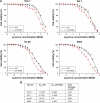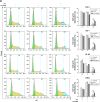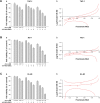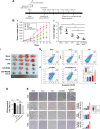Synergistic suppression effect on tumor growth of acute myeloid leukemia by combining cytarabine with an engineered oncolytic vaccinia virus
- PMID: 30410347
- PMCID: PMC6199215
- DOI: 10.2147/OTT.S172037
Synergistic suppression effect on tumor growth of acute myeloid leukemia by combining cytarabine with an engineered oncolytic vaccinia virus
Retraction in
-
Synergistic Suppression Effect on Tumor Growth of Acute Myeloid Leukemia by Combining Cytarabine with an Engineered Oncolytic Vaccinia Virus [Retraction].Onco Targets Ther. 2022 Oct 13;15:1119-1120. doi: 10.2147/OTT.S392085. eCollection 2022. Onco Targets Ther. 2022. PMID: 36246732 Free PMC article.
Abstract
Background: In consideration of the drug resistance and side effects associated with cytarabine, one of the most effective drugs for the treatment of acute myeloid leukemia (AML), there is a need for safer and effective strategies.
Methods: In the present investigation, we fabricated a new oncolytic vaccinia virus (oVV-ING4), which expresses the inhibitor of growth family member 4 (ING4) and explored its antitumor activity individually and in combination with cytarabine in AML cells.
Results: The experiments confirmed that oVV can efficiently and specifically infect leukemia cells, and augment the ING4 gene expression. Flow cytometry and western blot demonstrated that oVV-ING4 enhances apoptosis and G2/M phase arrest in AML cells, and causes remarkable cancer cell death. In addition, the synergistic efficiency of oVV-ING4 and cytarabine was investigated in vitro and in vivo; the combination significantly inhibited the survival of leukemia cells in vitro and xenografted KG-1 AML tumor growth in vivo.
Conclusion: In brief, oVV-ING4 can increase the sensitivity of leukemia cells to cytarabine and induce cell apoptosis in vitro and in vivo. Thus, oVV-ING4 may be a promising therapeutic candidate for leukemia and in combination with cytarabine represents a potential antitumor therapy.
Keywords: ING4; acute myeloid leukemia; combination therapy; cytarabine; oncolytic vaccinia virus.
Conflict of interest statement
Disclosure The authors report no conflicts of interest in this work.
Figures









Similar articles
-
Enhancing therapeutic efficacy of oncolytic vaccinia virus armed with Beclin-1, an autophagic Gene in leukemia and myeloma.Biomed Pharmacother. 2020 May;125:110030. doi: 10.1016/j.biopha.2020.110030. Epub 2020 Feb 27. Biomed Pharmacother. 2020. PMID: 32187960
-
ING4 expressing oncolytic vaccinia virus promotes anti-tumor efficiency and synergizes with gemcitabine in pancreatic cancer.Oncotarget. 2017 Sep 20;8(47):82728-82739. doi: 10.18632/oncotarget.21095. eCollection 2017 Oct 10. Oncotarget. 2017. PMID: 29137298 Free PMC article.
-
Embelin Promotes Oncolytic Vaccinia Virus-Mediated Antitumor Immunity Through Disruption of IL-6/STAT3 Signaling in Lymphoma.Onco Targets Ther. 2020 Feb 17;13:1421-1429. doi: 10.2147/OTT.S209312. eCollection 2020. Onco Targets Ther. 2020. PMID: 32110041 Free PMC article.
-
Engineering oncolytic vaccinia virus with functional peptides through mild and universal strategy.Anal Bioanal Chem. 2019 Feb;411(4):925-933. doi: 10.1007/s00216-018-1519-3. Epub 2018 Dec 7. Anal Bioanal Chem. 2019. PMID: 30523361
-
EMA Review of Daunorubicin and Cytarabine Encapsulated in Liposomes (Vyxeos, CPX-351) for the Treatment of Adults with Newly Diagnosed, Therapy-Related Acute Myeloid Leukemia or Acute Myeloid Leukemia with Myelodysplasia-Related Changes.Oncologist. 2020 Sep;25(9):e1414-e1420. doi: 10.1634/theoncologist.2019-0785. Epub 2020 Apr 13. Oncologist. 2020. PMID: 32282100 Free PMC article. Review.
Cited by
-
Recent progress in combination therapy of oncolytic vaccinia virus.Front Immunol. 2024 Mar 13;15:1272351. doi: 10.3389/fimmu.2024.1272351. eCollection 2024. Front Immunol. 2024. PMID: 38558795 Free PMC article. Review.
-
Development and application of oncolytic viruses as the nemesis of tumor cells.Front Microbiol. 2023 Jun 12;14:1188526. doi: 10.3389/fmicb.2023.1188526. eCollection 2023. Front Microbiol. 2023. PMID: 37440883 Free PMC article. Review.
-
Tutorial: design, production and testing of oncolytic viruses for cancer immunotherapy.Nat Protoc. 2024 Sep;19(9):2540-2570. doi: 10.1038/s41596-024-00985-1. Epub 2024 May 20. Nat Protoc. 2024. PMID: 38769145 Review.
-
Dendritic cells and natural killer cells: The road to a successful oncolytic virotherapy.Front Immunol. 2023 Jan 10;13:950079. doi: 10.3389/fimmu.2022.950079. eCollection 2022. Front Immunol. 2023. PMID: 36703982 Free PMC article. Review.
-
Design Strategies and Precautions for Using Vaccinia Virus in Tumor Virotherapy.Vaccines (Basel). 2022 Sep 17;10(9):1552. doi: 10.3390/vaccines10091552. Vaccines (Basel). 2022. PMID: 36146629 Free PMC article. Review.
References
-
- Zhang X, Xu LS, Wang ZQ, et al. ING4 induces G2/M cell cycle arrest and enhances the chemosensitivity to DNA-damage agents in HepG2 cells. FEBS Lett. 2004;570(1–3):7–12. - PubMed
-
- Cui S, Gao Y, Zhang K, Chen J, Wang R, Chen L. The emerging role of inhibitor of growth 4 as a tumor suppressor in multiple human cancers. Cell Physiol Biochem. 2015;36(2):409–422. - PubMed
Publication types
LinkOut - more resources
Full Text Sources

